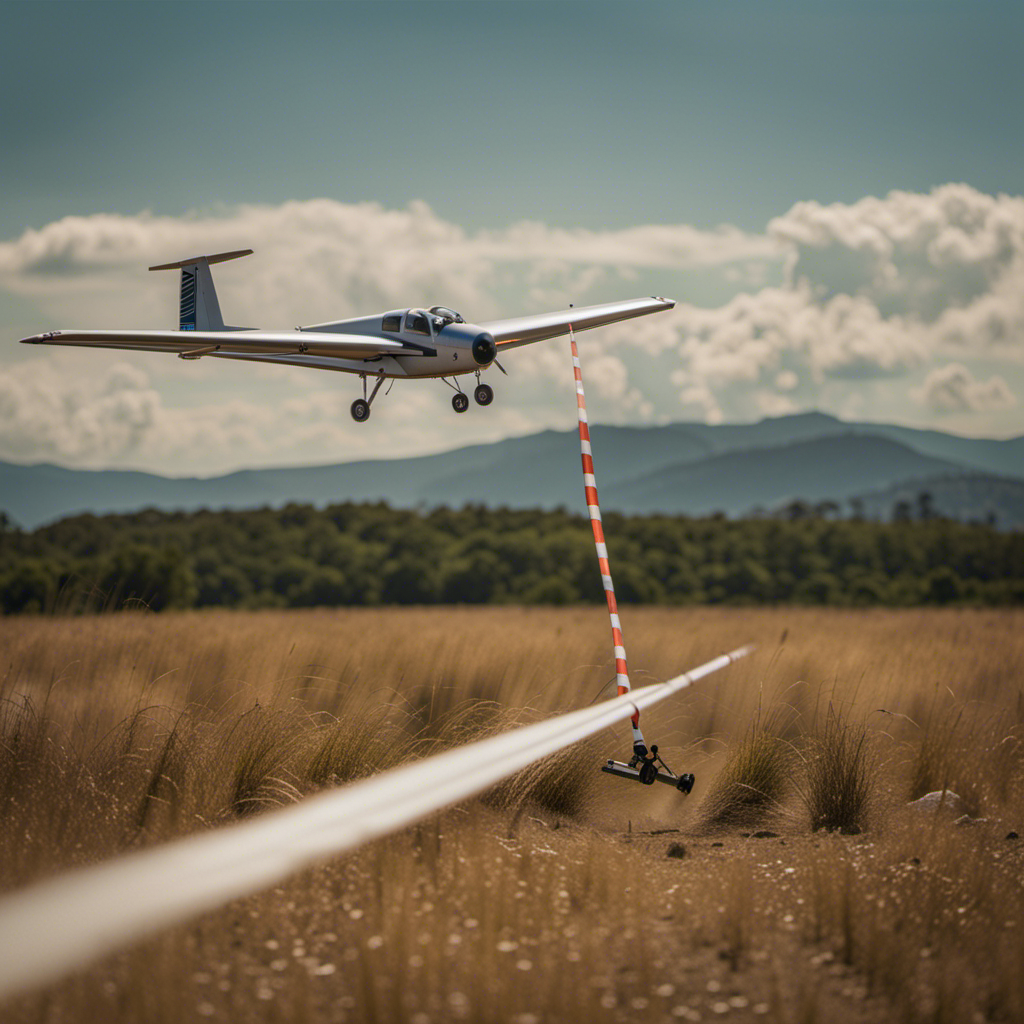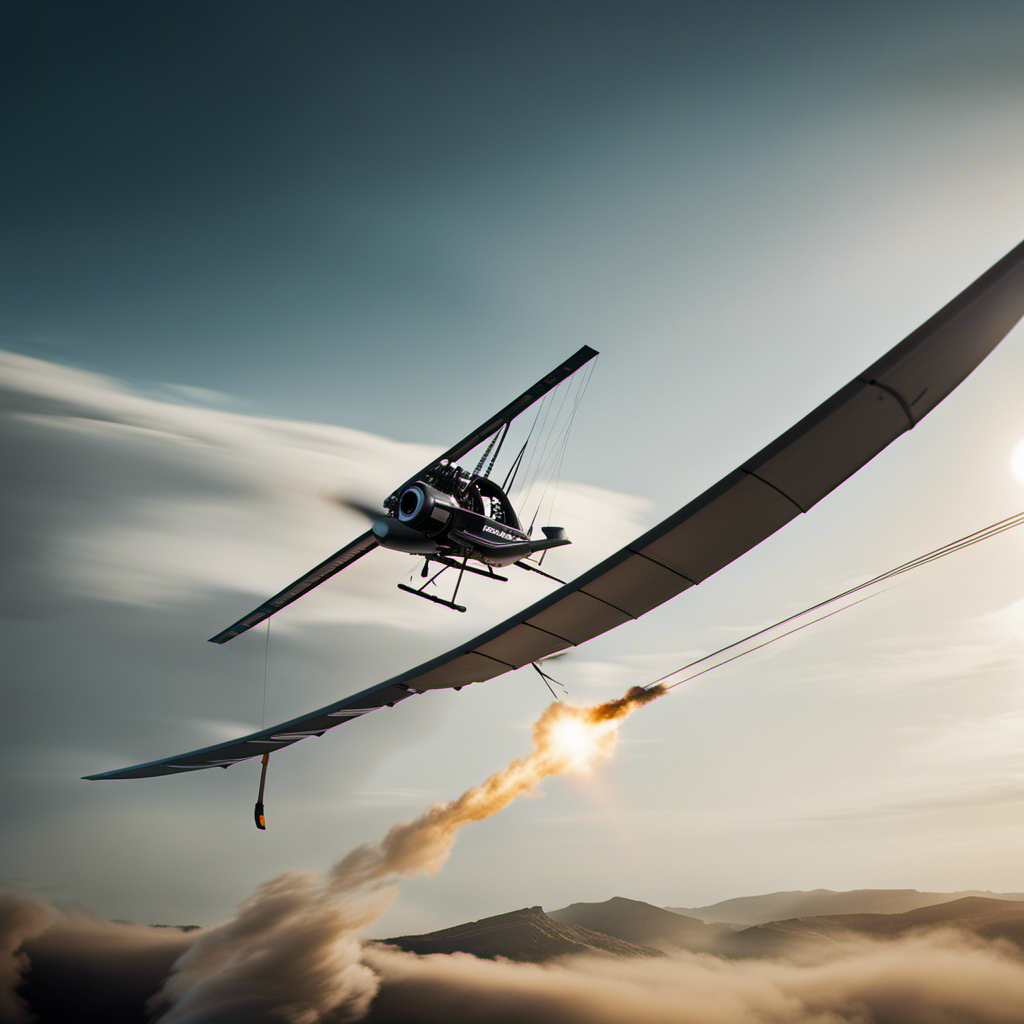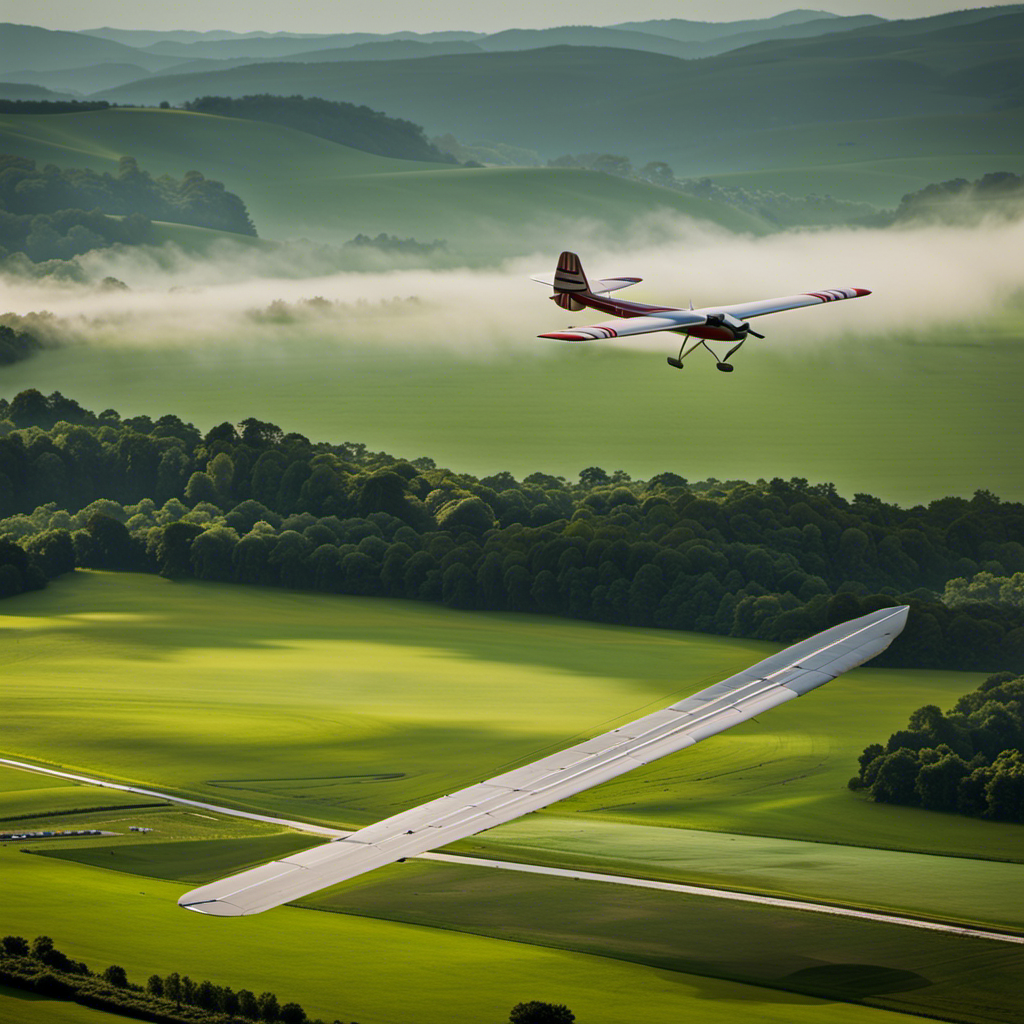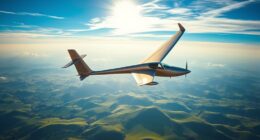As a passionate aviation enthusiast, I have always been intrigued by the allure and challenge of flying gliders.
But do you need a license to soar through the skies in these graceful aircraft?
In this article, we’ll delve into the intricacies of glider flying, uncovering the regulations, training requirements, and licensing process involved.
From understanding insurance considerations to exploring recreational and competitive flying opportunities, we’ll embark on a thrilling journey into the world of glider aviation.
So, fasten your seatbelts and prepare for an exhilarating adventure!
Key Takeaways
- Glider Pilot Training and Certification offers various ratings for different levels of flying, including solo and passenger flights, compensation for flying, and teaching and training opportunities.
- Written and practical examinations cover important topics such as airspace regulations, meteorology, aerodynamics, and emergency procedures.
- Maintaining currency and staying updated on regulations and weather information is crucial for safe glider operations.
- Joining glider clubs and communities provides access to experienced pilots, group flights, competitions, workshops, and seminars for guidance, support, and skill development.
Understanding the Basics of Glider Flying
To understand the basics of glider flying, you don’t need a license. Glider flying is a thrilling and unique experience that allows you to soar through the sky with the power of the wind. However, it is important to take certain safety precautions before taking to the air.
Researching local glider clubs is a great first step. These clubs have experienced instructors who can provide you with the necessary training and guidance to become a proficient glider pilot. They also offer a supportive community of like-minded individuals who share your passion for flying.
Safety should always be a top priority, so it is essential to familiarize yourself with the safety regulations and guidelines provided by the club. By understanding the basics and taking the necessary safety precautions, you can embark on this exhilarating adventure with confidence and peace of mind.
Transitioning to researching local aviation regulations and requirements, it is crucial to ensure that you comply with all the necessary legalities and training before taking to the skies.
Researching Local Aviation Regulations and Requirements
When it comes to glider flying, it’s important to understand the regulations set forth by the Federal Aviation Administration (FAA) in the United States. These regulations outline the requirements for pilot certification, airspace restrictions, and safety procedures.
Additionally, it’s crucial to familiarize oneself with the international regulations for glider flying. Different countries may have their own specific rules and guidelines.
Federal Aviation Administration (FAA) regulations in the United States
The FAA regulations in the United States don’t require a license to fly a glider. This is because gliders are classified as aircraft that are not intended for carrying passengers or property for compensation or hire. However, there are still important regulations that must be followed when flying gliders to ensure safety and prevent accidents.
Here are some key points to consider:
- Glider pilots must have proper training and certification to operate a glider safely.
- Gliders must comply with specific airworthiness standards and be regularly inspected.
- Glider flights must adhere to airspace restrictions and follow the rules of the air traffic control system.
These regulations are in place to maintain the safety of glider pilots and other aircraft in the airspace.
Now, let’s explore the international regulations for glider flying and how they differ from those in the United States.
International regulations for glider flying
Remember, it’s important to familiarize yourself with the international regulations for glider flying to ensure a safe and enjoyable experience. As a glider pilot, understanding these regulations is crucial for maintaining a high level of safety and adhering to the standards set by international aviation authorities. Compliance with these regulations ensures that all pilots, regardless of their country of origin, are operating their gliders in a consistent and responsible manner.
To help you navigate these regulations, here is a summary of some key international guidelines for glider flying:
| Regulation | Description |
|---|---|
| ICAO Annex 2 | Provides general rules and procedures for glider operations |
| ICAO Annex 6 | Covers the certification and operation of gliders |
| ICAO Annex 7 | Focuses on aircraft markings and registration |
| ICAO Annex 19 | Deals with safety management systems and accident investigation |
| ICAO Doc 9426 | Offers guidance on glider operations and procedures |
Seeking Proper Training and Instruction
To fly a glider safely, you should seek proper training and instruction from experienced pilots. Flying a glider requires a specific set of skills and knowledge that can only be acquired through proper training.
It is crucial to understand the operation of the glider, the principles of flight, and the safety precautions associated with glider flying. During the training, you will learn about the proper equipment necessary for glider flying, such as the control surfaces, instruments, and safety equipment.
Additionally, you will be taught how to perform pre-flight inspections, takeoff procedures, and emergency protocols. By receiving proper training and instruction, you will gain the necessary skills and knowledge to fly a glider safely and confidently.
Once you have obtained the necessary training, you can then move on to obtaining a glider pilot license, which will authorize you to fly independently.
Obtaining a Glider Pilot License
To obtain a private pilot license for gliders, there are several requirements that must be met. These include being at least 16 years old, having a minimum of 10 hours of flight time, passing a written exam, and demonstrating proficiency in various flight maneuvers.
Once the license is obtained, there are different levels of glider pilot certifications that can be pursued. These include the advanced and instructor ratings, which allow for more complex flying and the ability to teach others.
Requirements for obtaining a private pilot license for gliders
If you want to obtain a private pilot license for gliders, you’ll need to meet certain requirements. These requirements ensure that you have the knowledge and skills necessary to safely operate a glider. The Federal Aviation Administration (FAA) has established guidelines that outline the prerequisites for obtaining a glider pilot license. These requirements include being at least 16 years old, having a valid medical certificate, and passing a knowledge and practical test. Additionally, you must complete a minimum number of flight hours under the supervision of a certified flight instructor. To give you a better understanding, here is a table summarizing the requirements:
| Requirement | Description |
|---|---|
| Age | At least 16 years old |
| Medical Certificate | Valid certificate issued by an aviation medical examiner |
| Knowledge Test | Pass a written examination |
| Practical Test | Pass a flight test with an FAA designated pilot examiner |
| Flight Hours | Complete a minimum number of flight hours |
| Instructor Supervision | Fly under the supervision of a certified flight instructor |
Once you meet these requirements, you can move on to the next section, which covers the different levels of glider pilot certifications.
Different levels of glider pilot certifications
The different levels of glider pilot certifications can provide pilots with opportunities to enhance their skills and pursue more advanced flying experiences.
Glider pilot training includes a series of ratings that pilots can obtain as they progress in their training. These ratings indicate the pilot’s proficiency and knowledge in different aspects of glider flying.
The ratings start with the Private Pilot Glider rating, which allows pilots to fly solo and carry passengers. As pilots gain experience and knowledge, they can pursue the Commercial Pilot Glider rating, which allows them to be compensated for their flying.
The highest level of certification is the Flight Instructor Glider rating, which enables pilots to teach and train aspiring glider pilots. These certifications not only showcase a pilot’s expertise but also open doors to more challenging and rewarding flying opportunities.
Transitioning to the next section, completing written and practical examinations is an essential part of the certification process.
Completing Written and Practical Examinations
After passing the written and practical examinations, you’ll receive your glider flying license. These examinations are crucial to ensure that you possess the necessary knowledge and skills to safely operate a glider. Here is what you can expect during the examination process:
-
Written Examinations:
-
Cover a wide range of topics, including airspace regulations, meteorology, aerodynamics, and emergency procedures.
-
Test your theoretical understanding of glider flight principles and regulations.
-
Require thorough preparation and study to pass.
-
Practical Examinations:
-
Evaluate your ability to apply the knowledge learned in real-world situations.
-
Include tasks such as pre-flight inspections, takeoffs, landings, and emergency procedures.
-
Require demonstration of proficient flying skills and decision-making abilities.
Once you have successfully completed these examinations, you’ll be ready to take to the skies as a licensed glider pilot. It’s important to note that maintaining currency and staying up to date with regulations and procedures is essential for safe and responsible flying.
Maintaining Currency and Staying Up to Date with Regulations
To stay current and comply with regulations, it’s important for you to regularly review and update your knowledge of airspace regulations, meteorology, and emergency procedures. Maintaining currency in these areas is crucial for the safety of yourself and others. By staying up to date with airspace regulations, you can ensure that you are aware of any changes or restrictions that may affect your flying operations. Meteorology knowledge allows you to make informed decisions about weather conditions and plan your flights accordingly. Understanding emergency procedures is vital for handling unexpected situations and ensuring a safe outcome. To help you visualize the importance of maintaining currency, here is a table highlighting the key areas to focus on:
| Area | Importance | Resources |
|---|---|---|
| Airspace regulations | Comply with rules and restrictions | FAA website, Aeronautical charts |
| Meteorology | Make informed weather decisions | Weather forecasting services, METAR |
| Emergency procedures | Handle unexpected situations | Flight manuals, Training courses |
Understanding Insurance and Liability Considerations
Understanding insurance and liability considerations is crucial for ensuring the protection of yourself and others when flying a glider. When it comes to insurance coverage, it is important to have a policy that specifically covers glider operations. Standard aviation policies may not provide adequate coverage for glider-related accidents or damages.
It is advisable to consult with an insurance professional who specializes in aviation to ensure that you have the right coverage for your needs. Additionally, there are legal implications to consider. Flying a glider without appropriate insurance coverage can expose you to significant financial liability in the event of an accident.
It is important to understand the laws and regulations surrounding liability in your jurisdiction to protect yourself and others. By being knowledgeable about insurance coverage and legal implications, you can fly with peace of mind and responsibly participate in the glider community.
Joining Glider Clubs and Communities
When you join glider clubs and communities, you’ll have the opportunity to connect with other passionate glider pilots and enthusiasts. Being part of these communities comes with a range of benefits and exciting events that will further enhance your gliding experience. Here’s a glimpse of what you can expect:
-
Glider Club Benefits:
-
Access to a network of experienced pilots who can offer guidance and support.
-
Opportunities to participate in organized group flights, competitions, and cross-country adventures.
-
Glider Community Events:
-
Airshows and fly-ins where you can showcase your skills and admire the talents of other pilots.
-
Workshops and seminars covering various aspects of gliding, including safety, maintenance, and advanced techniques.
Exploring Recreational and Competitive Flying Opportunities
If you’re looking for new and exciting flying experiences, exploring recreational and competitive opportunities in gliding is a great choice. Glider flying offers a unique and exhilarating way to take to the skies, whether you’re a thrill-seeker or a competitive enthusiast. Let’s take a closer look at the various options available in recreational flying and the exciting world of competitive flying events.
| Recreational Flying Options | Competitive Flying Events |
|---|---|
| Scenic joy flights | Glider aerobatics |
| Cross-country soaring | Glider racing |
| Ridge soaring | Aerotow competitions |
| Wave flying | Distance challenges |
Recreational flying options allow you to enjoy the beauty of the landscape from above, experiencing the freedom of gliding through the air. On the other hand, competitive flying events challenge your skills and push you to achieve new heights in glider aerobatics, racing, aerotow competitions, and distance challenges.
Embracing the thrill and freedom of glider flying is an incredible journey that will satisfy your passion for aviation and open up a world of endless possibilities. So, let’s dive deeper into the world of glider flying and discover the joy it brings.
Embracing the Thrill and Freedom of Glider Flying
To fully embrace the thrill and freedom of glider flying, it’s important to immerse yourself in the exhilarating experience of soaring through the sky without an engine. Glider flying offers a unique adrenaline rush that cannot be replicated by any other form of aviation.
The feeling of being completely at one with the elements, harnessing the power of the wind to stay aloft, is truly unmatched. Finding the perfect glider flying locations is key to maximizing this experience. Look for areas with favorable weather conditions, such as consistent thermal activity and gentle winds.
Mountainous regions often provide excellent opportunities for dynamic soaring, where the glider can ride the updrafts created by the terrain. Coastal areas can also offer strong sea breezes, ideal for ridge soaring. By seeking out these ideal locations, glider pilots can fully embrace the pure joy of flying without an engine.
Frequently Asked Questions
How much does it cost to obtain a glider pilot license?
Obtaining a glider pilot license typically costs around $2,000 to $3,000. The requirements include completing a minimum number of flight hours, passing written and practical exams, and meeting medical and age criteria.
Are there any age restrictions for flying a glider?
Age restrictions for flying a glider depend on the country and organization. Generally, individuals must be at least 14-16 years old to begin training. Training requirements include theoretical knowledge, practical flight experience, and passing exams.
Can I fly a glider if I have a fear of heights?
Overcoming a fear of heights is possible when flying a glider. Mental preparation and training help build confidence, allowing you to soar above your fears. Focus on the exhilaration of flight, like a bird spreading its wings.
Are there any medical requirements to become a glider pilot?
To become a glider pilot, one must meet specific medical requirements and undergo regular medical examinations. These examinations ensure that pilots are physically fit to operate a glider safely and efficiently.
Can I fly a glider without joining a glider club or community?
Yes, you can fly a glider solo without joining a club or community. However, it is highly discouraged due to the importance of glider safety and the benefits of being part of a supportive community.
Conclusion
In conclusion, embarking on the journey of glider flying is like soaring through the vast expanse of the sky, with the wind as your guide and the horizon as your destination.
Just as a bird spreads its wings and takes flight, obtaining a glider pilot license allows you to experience the freedom and thrill of this remarkable sport.
By joining glider clubs and communities, you can connect with fellow enthusiasts and explore recreational and competitive flying opportunities.
So spread your wings, embrace the challenge, and let your dreams take flight in the world of glider flying.
Orion, better known as “Jetstream,” is the voice that brings the stories of the skies to life. His fascination with aviation began at a young age, sparked by his father’s tales of flying and adventure. Orion’s journey into the world of gliding was serendipitous, and from the moment he took his first glider flight, he knew he had found his calling.










